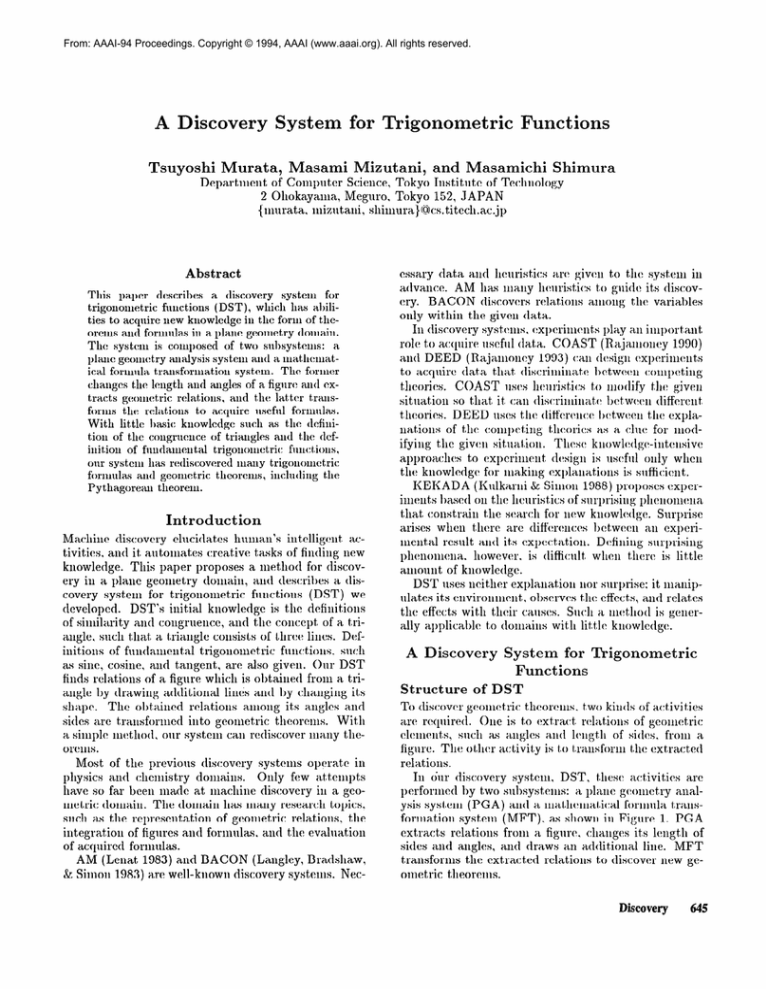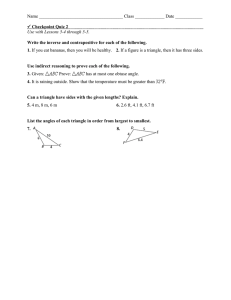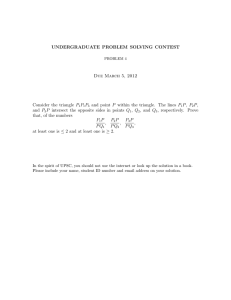
From: AAAI-94 Proceedings. Copyright © 1994, AAAI (www.aaai.org). All rights reserved.
A Discovery
Tsuyoshi
System
Murata,
Department
Masami
for Trigonometric
Mizutani,
Functions
and Masamichi
Shimura
of Computer Science, Tokyo Institute of Technology
2 Ohokayanm, Meguro, Tokyo 152, JAPAN
{ inurata, iuizutaiii, sliiiuura}@!cs.titecli.ac.jp
Abstract
This paper describes
a discovery
system for
trigonometric
fuctions
(DST),
which has abilities to acquire new knowledge in the form of theorcins ancl foriiialas ii1 a plant: geometry cloiiiaiil.
The systcn1 is composed of two suhystenls:
a
plaiic: geonhry
analysis systeiri ad a niatlicniatical fornda
t,ratnsforlllat,ioll system. The former
changes the length and angles of a figure and extracts geouietric relations, and the lat,tcr transforiiis the relations to acquire nsefnl formnlas.
With little lmsic: knowledge such as the clefinitioii of the congruence of triangles aid the dcfiiiition of fiuidameiit~al trigonometric
fiuictions,
our system has recliscovered many trigononietric
formulas ant1 geometric theorems, including the
Pythagorean
tlieoreui.
Introduction
Madline discovery elucidates human’s iutclligout activities, and it, automates creative tasks of finding new
knowledge. This paper proposes a met~hocl for discovery in a plane geometry domain, and describes a discovery system for trigonometric
funct,ious (DST) we
developed.
DST’s hitVial knowledge is the definit*ious
of siniilarity illld congruence, and the concept, of a triangle, such that0 a triangle consists of three lines. Definitions of fluldalllelltd
trigolloillctric
fuiictious. such
as she, cosine, and tangent,, are also given. Our DST
finds relations of a figure which is obtOaiuetl from a triangle by drawing adtlitiond
lines aid by clmugiilg its
shpt.
The olhh~ecl relat,ious among its angles and
sides are tm,ilsforiiied into geoiuetric theorems.
Wit,11
a simple Iut!tllocl. 0111’ system
call
rediscover
IlliLlly
tlle0lT111s.
Most of the previous discovery systems operate in
Only few atttempts
physics and cliciiiistry donmiiis.
have so far beeu made at inacliine discovery iii a geometric domain. The domain has nlany research topics,
sucli as the rcpresent,at~ion of geometric relations, the
iiitegratioii of figures ant1 formulas. and the evaluation
of acquired forinulas.
AM (Lenat, 1983) and BACON (Langley, Bratdsllaw,
St Simon 1983) are well-known discovery systems. Nec-
cssary data and lieuristics itro givoii to the system in
adva~~cc. AM has llli~lly heuristics to guide its discovery.
BACON
discovers
relations
among
the variables
only within the giveii data.
Iii discovery systSt:llls, c:xpwilll~~llts play all illlport~allt,
role to acquire useful data. COAST (R:Lji~llloll~~y 1990)
iLu(l DEED (Rajamouey
1993) can tlcsigi~ c:xperinieiit,s
to acquire tlat,a tl& cliscriii~iiiatte l~Ctweoi1 coiiipetiiig
theories.
COAST uses heuristics t,o modify the given
situatioii so that it, can dis(*riiuiimtc bot.woeil clifferciit~
t,lleories. DEED uses the tlifforcmco botwoeu the explanatioiis of the coiiipetirig theories ilS a clue for iiiodifyiug the give11 sit,uat,iou. These kllowl~~dgc~-illtt~llsive
i-Lpp~OiLCllt!S
to experiiiieiit
clctsigii is useful oiily wllcii
the kuowledgc for making explamtions
is sufliciont.
KEKADA
(K IIlk arui SC Siulou 1988) proposes experiiiieiits based on t,lie heuristics of surprisiiig plieiionieua
that, constrain the search for new kuowlcclge. Surprise
arises wlieu there are tliffcroiices 1)otwcon au experinlental result ant1 its oxpectatiou.
Ddilliug
surprising
pl~enoimna,
however, is tlifficult~ wlieu there is little
amount of knowledge.
DST uses neither explauatiou nor surprise: it manipulates its cnviroiiiiieiit. ol)servcs the effects, and relates
the effects with their CiLlIWS.
Such a u1etliod is geiierally applicaldc to cloulaius wit,11 little knowledge.
A Discovery
Structure
System for Trigonometric
Functions
of DST
To discover goolnetric thoorerm, two kiucls of ahivities
Oiie is to extract, rolatioiis of geoiiietric
art3 required.
clolllcllts,
sllcll as iLl~~lOS and l~mgtll of sides, from a
figure.
The other activity is to t~iL11sforlll the extracted
relations.
111 dw
discovery
system,
DST,
these
activities
are
a plane gooiilctry
aiialby two sllbsyst,ellls:
ysis system (PGA) and a ulatllematical
forluula t,ransas show11 ill Figure 1. PGA
formation system (MFT).
extracts relations from iL figure, cliauges its length of
sides and angles, and draws an additional
line. MFT
transforms the extracted relations to discover new geometric theorems.
p”rforllled
Discovery
645
o Extraction
Plane Geometry
r
Analysis System - Specialization of figures
- Addition of new lines
- Extraction of relations
t
Specialization of figures P(~rforluiiig spc~cializatioii
is one way to make experimcmt~s ill a gconhric
domain.
Specialization
of a tlh,llgl~
(Zilll h doiie iii tlic followiiig
way:
0 changing
discovered
theorems
relations
- Elimination of subproducts
- Transformation to
trigonometric formulas
1: Two subsystenls
two angles qua1
o nlaking
two sides equal
Addition
of new lines Addit8iou of new linw to a
often clarifies IYtli~tiOllS aiiioiig its basic elciilciits.
An additional line divides a figure illto two snlallcr figIliVS, alltl tllft rctlattiolis CXtl’iKt(!(l flVll1 OiL(‘ll siiiallcr figure are conlbiuctd to find relations in tlltt figure. Additioual lines drawl1 by PGA art! as follows:
figure
of DST
initial knowledge is only for analyzing
e Definitions of sine, cosine, and tangent
two sides in a right triangle
e Axioms
-
figures:
as ratios
of
of plane figures
- If two triangles are congruent,
sides aiid au&es are equal.
their corresponding
If two triangles arc similar, their corresponding
angles and the ratios of length of their correspouding sides are equal.
The former definitions are necessary t,o express the
rolatious of sides and angles. The latter characteristics
between two triaiigles, such as the siiiiilarity and coiigruence, are needed since a triangle is the fundamental
element.
T11e amountV of initial knowledge varies according to
the purpose of discovery systems. Knowledge-inteusivc
discovery systeius use considerable aniouiit of basic domaiu knowledge to acquire advanced knowledge. Discovery with too 11luc1~initial knowledge is, however,
notliiilg more tlliLl1 the transforiiiatioi~
of the given
knowledge. While our DST aims at, initial exploration
and can discover theorems with very few initial knowledge.
Plane
Geometry
Analysis
System
The role of PGA is to generate figures from an arbitrary triangle aud to exhact relations among sides and
angles for MFT. PGA has the following n~echauisms:
0 Specializatioii
o Addition
646
of figures
of new lines
MachineLearning
to a right triangle
o making
e
DST’s
a trixiigle
In soinc cases. giving on0 sI)(~(:iiLlizat,ioii causes other
relations among sides and angles. For exitlllplc, nmkiug
two angles of a triangle eclllal call be a result8 of making two sides equal. The former spe(:ializi~tion implies
the latter, which can 1~ coiisidorod as a iiew thcoreiu.
Among specialixation,
cliaiigiiig a triaiiglo to a right
triangle is often useful since t,rigoiionic!t,ri~ fuiictioiis
are dcfincd with a right triangle.
Mathematical Formula
Transformation System 1
Figure
of relations
a bisec:t40r Of ali allgle
0 a bisector
of
il
e a perpendicular
sitlc
lines from
iL
vcrtox
Additional lines generate 11cw elements. such as sides
and iLllglCS. which are CiLlld .s2/,bp7’0(~.1L(‘t.s. Al thugll
slll~p~Od1ICt~sare llseflll for C:Xtl%(*tillg ll(‘W rehtiolls,
they
caiiiiot
1~: used
should be eliniinated
to
express
iicw
tliooreiiis
and
later.
Extraction
of relations A figure consists of basic
elements, such as points, liiies , allgles and triangles. A
cliango iii one olcii~eiit oftm causes side effects to other
parts of the figure.
111PGA, the same kind of basic olcmellts are gro~~pcd
togt:tller.
The elcnlents iu the saul( group are tombined toget,h
to form a differentr kind of olcn~eut, and
relations among them are found. Aft,cr finding the FClations, PGA se11t1s them t,o MFT for further process.
As show11 in Figure 2. an a(l(liti~~llal liuc CH is drawn
011 a triangle ABC, and relat8ious anlong the length of
lines are extra(:ted.
Two liues which share the same
~11~1are conlhled
to make itI1 angle, au(l relations of
adjaceiit angles arc cbxtractetl.
Silllilally,
tllrcct lines
are conllh~cd to nlak(b a trianglc~, aud relations of congnlellt
or similar triangles arc iLlSO CXtrit(Tte<l. Lines.
angles, and triangles WC! i~iiitiially related iii this way
so thatt specialization
to ail ctleiiictiit~ is prOpagatc(1
to
the rest, of the
eleiiieiits
iii tlic figurc~.
Mat hemat ical Formula
System
Transformat
ion
The role of MFT is to discover theormls from the formalas which express t,he extracted relations.
The dis-
A
R
c
Lines
I.....................
.,..............
,
Lines f&m&g
Tr ia ng les
.................*
Finding congrukt
or similar triangles
;
:
A
AH+HB=AB’
LAHC+LBHC=180”
LACH+LBCHdACB
Extracted relations
Figure
2: Extraction
covcry of MFT is perforlmd
by tramposition,
substitOution, ad fundamental
arithietic
operat,ions.
1. Generation of a theorem
To generate a tlleorem, MFT elilninates subproducts ill the obtained relations by rcpeatiiig substitution.
If the result of substitution contains ii0 suhproduct variable, it can be considered that, a tlleorenl is generated.
The conditional
part, of the theoreni is obtained from the fomiulas of
the figure before drawing atlditioiial lines. aiid die coiisequent part is from the acquired formulas.
Figure 3 shows a process of discovering a theorem,
“An isoscclcs t,riatngle has equal base angles.” The relation obtained from a triangle ABC before drawing an
additional line is the given condition AB=AC.
MFT
draws a perpendicular
line AH from vertex A to side
of relations
BC. and generates two congruent8 thllgles,
LJAHB am1
AAHC. Among newly extracted
rc>lattions, LABC =
LACB contains no subprodncts.
Since the line does
not a&l any new constraints
to tlic original triangle.
the relation is considered
as a cliatracteristic: of t,lie
isosceles tOriangle. Therefore.
tllcx tlleorenl is obtained
of which conditiolla.1 part, is AB=AC
mtl consequent,
part is LABC = LACB. A s swii iii the above l~rocess,
it is found thk the tlieoreiii is ol~taiiiecl from the relations wliicll are extracted before alit1 after drawing the
line.
As a result of subproduct elinlhation,
formulas with
iim,iiy ternis or with coiliplox t8~:riiisarc oftmi generated.
MFT does not, use these forlllulas for subsecluont~ tramforiiiatioii since t,liey cause ctxplosivc~ incrmsc of foriiiulas. To put it more collcretcly. the results of the sub-
Discovery
647
0 taxi 0 - sin @/siii( 90” - 0)
Before drawing
an additional line
0 tail 8 = l/ta11(90°
o Au isosceles triangle
+
Its base angles are equal.
A
@A
l
c
B
i’~~A~E~Kc~.i
....................
AB=AC
I
subproducts
IF-part i
BH=CH
LBAH=LCAH
L ABH= L ACH
L AHB= L AHC
,..........-.I--.--.-.-...............*
;.““““““..‘
LABC=LACB
I
..“~.......~......~.~
;
Then-part
AB=AC
)
=, L ABC= L ACB
Discovered theorem
3: Discovery
of a geometric
theorem
stitution that, increases the ininiher of subproducts are
discarded.
Formulas whose dixneusiou is higher than
three are also discarded.
The number of forxnula transformatiou
is also coustrained in LEX (Mitchell et al. 1981) which treats
symbolic integration.
Heuristics about the application
of its operators are the criteria for forinula transformation.
In MFT, the dimension of formulas aud the
number of variables are used as the criteria, since the
formula trausforxnatioxr depeuds solely 0x1 the selection
of formulas.
2. Trigonometric
representation
1x1order to acquire trigonometric
theorenis, discovered theorexns in
the above process have to be trausfornled.
That is,
variables expressiug sides of a right triangle are eliminated from the theorem by using the defiiiition of
trigonometric
functiom.
By introducing basic trigonometric fuuctious such as siue? cosine, aud tangent,
a formula sin28 + cos28 = 1 is acquired from the
Pythagorean
theorem which is discovered previously.
Results
The itcnls listed below are some of the theorexns
DST has rediscovered from a triangle.
0 taxi 8 = sin
648
l9)
0 sin20 + cos2Q = 1
A
Figure
-
elc0s 8
MachineLear&&
that
triangle of eyual base a11glos
--f
It is an isosceles triaiigle.
A right triangle
+
The Pythagorem
theomu
holds.
The first four thcorexns arc well- kuowu fuudaxueutal laws of trigonoiiietric
fiiiictioiis, and the rest, arc
obtained by iuterpretiug
the i&ttioi~ of acquired forxnulas. 1x1the ulauuer described a,lmvo, MFT geuerates
a uuxnber of formulas. For exaxuple. the Pythagorcaxi
theoreru is fouutl as EXPR4024
forum1 by EXPR3804
and EXPR4023,
as shown in Figure 4. Iii general.
Pythagorean
tlieoreiii can be proved leased on the coniparison of area of atlditioual scluares.
It should be
noted that DST fiuds the theorexu ouly by xnalthenlatical trai~sforiiiatioii without, using t,lio coiicept, of area.
The figure is geuerated by chmgiug au augle to a right
angle aiid by drawing a l~~~rl~~~xldi~:llli~~
liue from a vertex to its opposite side. PGA fiuds that the triangles
AABC, APBA. and APAC are similar triangles since
they have corresponding
angles.
Extracted
relatious
are that, the ratios of adjaceut, sides of the correspondiiig aiigles are equal. Other geouiotric relations, such
as BP + CP = 13C, are also extracted.
Finally, MFT
discovers the theorexu AB” + AC2 = BC”, which iuchides 110 subproduct, such as AP, BP, and CP.
In Figure 4, EXPR3G3G and EXPR.3810
involve subproduct, variables AP, BP, and CP. MFT eliluiuates BP
froxu these two expressions aud produces EXPR.4022.
Then MFT finds EXPR.3806
which iuvolvcs the same
subproduct~ variables iu EXPR4022
to elixuinat,e AP.
In the same maxmer, EXPR.3804
is used to elixniuate
CP. Finally MFT discovers EXPR4024
which involves
ii0 subproduct.
aud this forulula is the well-kuowu
Pytliagoreaii
tlieoreiii.
PGA geuerates figures by perforuiiug
all possible
specializatioii
and additioii of lilies to t#lie givoii figure. All the figures coustit+ute a tree struct,ure whose
node shows a generated figure ant1 whose arc shows
specialization
or addition of liues. PGA selects oue of
the node for its aualysis in the breadth-first, order. Geometrically
equal figures possibly itppcxir
iii different.
uode in the tree. These figures are. howcvcr, cousideretl as different figures in PGA, since they are ideutified as a sequence of specialimtiou
and addition of
lines. Generally the discovered theorem would be the
same if the aiialyzed figures are equal, eveii if they apHowever. theorenls actually
pear iii differeut~ nodes.
discovered from the figures are uot always the same.
For example, the fifth and the sixth theorems listed
above are rediscovered separately iu DST, though the
figures used for the discovery are geonietrically
equal.
BP+CP~~;~;;~
AB-CP=APeAC
~~~0806
AB*AP+AC*CP=AC*BC
;
AEI? CP + AC? CP = AdBC
AC*= BC. CP
F/ExPR~~~~
AB*+ AC*= BC*
EXPR4024
Figure
4: Discovery
of the Pythagorean
MFT conlbines theorems which are discovered from
different figures to generate iiew different theorems.
From the first, and the secoud theorems listed above, a
theoreni %OS 8 = siii(90” - ey will be generated.
Discussion
As Zytkow aud Baker pointed out (Zytkow Sr. Baker
1991). experinientatiou
has a nuinber of advaiitages
over mere xnanipulation of given data, siuce au abuudance of data are provided, the quality of data is inlproved, inrportaut data for constructiug
theoreuls can
be obtained, and various situations are created so that
regularities
of data are easy to discover.
Manipulation 0x1 figures to get useful data corresponds
to experinreutation
iu a plaue geoxnet,ry donlain. DST autoiioniously niai~il~ulat~es its eiiviroiiineiit aiid acquires
data in order to discover with little initial knowledge.
To evaluate the geuerality of discovered laws or theorems enhances t,heir utility. ABACUS
(Falkeuhainer
Sr. Michalski 1986) employs discrinliuaut
descriptions
of classifying observed data into classes in generated
iiunieric laws. FAHR.ENHEIT
(Zytkow 1987) specifies the scope of discovered laws as extended uunleric
laws. Our DST analyzes aud specializes figures nuder
geometrical constraints.
The scope of theorenls discovered iu DST, therefore, is given by such coustraints of
analyzed figures in the specialization
process in a plane
theoron
geonictry.
Iii order to evaluate the utility of couccpts iuid to
restrict the search space of discovery process, AM uses
The criteria are. however, fixed by
“iuterestiiigiiess.”
the iuitial defiuitious of coucopts.
The couiplexit,y of
expressions in DST is evaluated by t#he uuluber of variables, dixneusions of forxnulas, and t#ho uuxnber of subproducts. Though DST has uo similar c:rit,eria to AM,
eliiiiiiiatioii of subproducts
t,urns out, to be ail effcctivc approach for discoveriug useful theorems.
Also
the eliiiiiiiatiou avoids the ~‘0llll~ill;tt,i0lliLl c~xplosion of
foriiiulas since it, restricts the S(!iUY:ll space of forinula
traiisforiiiatioii.
Sonietiiiies,
however, we eucouxiter the case where
theoreiris eiiiployiug subproduc:ts iL1’(: iiiilmrtant~ iii a
To fiutl such theoroxu, formulas obtarget, doiiiaixi.
taiued iu PGA should uot, be eliuiiuated.
For exaulple.
to fixid theorouis about a ceiitor of gravity iii a triaiigle. additional lilies to a triaiiglo are required.
It,
is iiiiportaiit,
therefore, to disc:rixllillittc geouietrically
iiiiport~aiit subproduct~s from ulere itllxiliary ones.
Concluding
Remarks
We have developed a discovery systcni for trigoiiouietric functions in a plane geometry.
Our system rediscovers iiiaiiy theorexns, iiicludiug the Pythagoreaii
theorem, with a simple method. It should be noted that
Discovery
649
DST rediscovered from quite little knowledge.
In a
similar nmlner of hunlan probleul-solving
in a plane
geometry domain. PGA acquires relations among basic elements under various conditions.
MFT gencrates 10,000 formulas to discover the theorems described
above. Omitting useless formulas during its trausforination avoids the generation
of explosive nuiiibcr of
fornlulas.
One direction to extend DST is to consider new basic
elements, such as circles and four-sided figures.
If a
circle is added as a basic element, relations about, an
inscribed circle and a circle circuluscribing
a triangle
will be extracted by PGA.
Acknowledgments
We would like to thank Dr. Sonlkiat
his insightful coimnents.
Tangkitvauich
for
References
Falkenhainer.
B.C., and Michalski,
R. S. 1986. Integrating Quantitative
and Qualitative
Discovery:
The
ABACUS System
Muchine Learning l(4): 367 401.
Kulkarni, D., and Simon, H. A. 1988. The Process of
Scientific Discovery: The Strategy of Exl>erilllent,attioll.
Cognitive Science 12( 2): 139.--175.
G. L., and Simon,
H.
Langley,
P. W., Bradshaw,
A. 1983. Rediscovering
Cheulistry
with the BACON
System.
In Michalski,
R. S., Carbonell,
J. G., and
Mitchell, T. M. eds. Mac&m
Learning : An Artifkial
Intelligence Approach,. : Tioga.
Lenat, D. B. 1983. The Role of Heuristics in Learning by Discovery:
Three Case Studies.
In Michalski,
R. S., Carbonell, J. G., and Mitchell, T. M. eds. MuApproach.
chine Leuming
: An Artificial Intelligence
: Tioga.
Mitchell,
T. M., Utgoff,
P. E.,
Nudel,
B.,
and
Banerji R. 1981. Learning Problem-Solving
Heuristics
In Proceedings
of the Seveiith InThrough Practice.
ternational
Joint Conference on Artificial Intelligence,
127--134.
Rajamoney,
S. A. 1990. A Computational
Approach
To Theory R.evisiou. 111 Shrager, J., and Langley, P.
eds. Conapututional
Models of Scientific Discovery (~n.d
Z%eorg Formation.
: Morgan Kaufmanu.
Rajanloney,
Experiments.
S. A. 1993. The Design of Discrimination
Muchine Learning 12( 1): 185.-203.
Zytkow, J. M. 1987. Combining many searches in the
FAHR.ENHEIT
cliscovery system.
111 Proceedings
of
the Fourth International
workshop on Machine Learning, 281-287.
: Morgan Kaufmann.
650
Machine Learning
Zytkow, J. M., and Bak(br. J. 1991. Iutoract,iv(~ Miuiug of Regularities in Datnbasc~. 111Pi(zt.c!t,sky-SlI~Ll)iro,
G., and Frawlcy, W. J. eds. Km~~ddgc
Discowr-y in
Databases . : The MIT Press.




